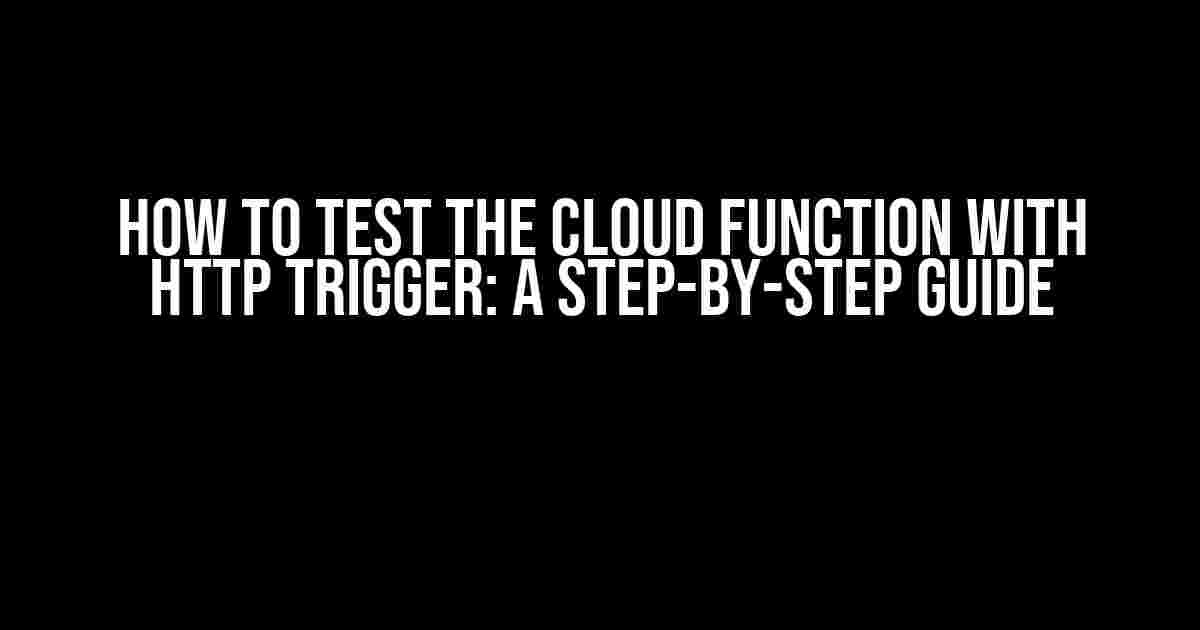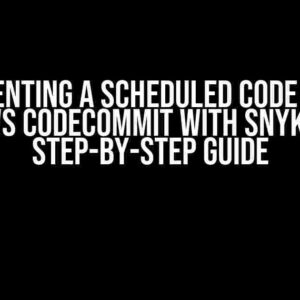Are you tired of wondering if your cloud function is working as expected? Do you want to ensure that your HTTP trigger is firing correctly? Look no further! In this article, we’ll take you on a journey to demystify the process of testing cloud functions with HTTP triggers. Buckle up and get ready to learn!
What are Cloud Functions and HTTP Triggers?
Before we dive into testing, let’s quickly refresh our understanding of cloud functions and HTTP triggers.
A cloud function is a small, self-contained piece of code that runs on a cloud platform, such as AWS Lambda, Google Cloud Functions, or Azure Functions. It’s a serverless computing model that allows you to focus on writing code without worrying about the underlying infrastructure.
An HTTP trigger is an event that invokes a cloud function when an HTTP request is sent to a specific URL. This trigger allows your cloud function to respond to incoming requests, making it an essential component of serverless architectures.
Why Test Cloud Functions with HTTP Triggers?
Testing cloud functions with HTTP triggers is crucial for several reasons:
- Ensure Correct Functionality**: Verify that your cloud function is executing correctly and producing the expected output.
- Identify Bugs and Errors**: Catch any bugs or errors that might be present in your code, preventing unexpected behavior in production.
- Improve Performance**: Optimize your cloud function’s performance by identifying bottlenecks and areas for improvement.
- Enhance Security**: Validate that your cloud function is properly handling HTTP requests and protecting against potential security threats.
Tools and Prerequisites
To test your cloud function with an HTTP trigger, you’ll need the following tools and prerequisites:
- Cloud Platform Account**: A registered account with a cloud platform provider, such as AWS, Google Cloud, or Azure.
- Cloud Function Created**: A cloud function with an HTTP trigger set up and deployed to your chosen platform.
- cURL or HTTP Client**: A tool like cURL or an HTTP client library (e.g., Postman, HTTPie) to send HTTP requests to your cloud function.
- API Gateway or Endpoint**: A publicly accessible API gateway or endpoint that exposes your cloud function to HTTP requests.
Testing Methods
There are two primary methods for testing cloud functions with HTTP triggers: manual testing and automated testing. We’ll cover both approaches in detail.
Manual Testing with cURL
Manual testing involves sending HTTP requests to your cloud function using a tool like cURL. This approach is ideal for quick, ad-hoc testing and verification.
curl -X POST \
https://your-api-gateway.com/your-cloud-function \
-H 'Content-Type: application/json' \
-d '{"key": "value"}'
In this example, we’re sending a POST request to the API gateway endpoint, which triggers the cloud function. The `-H` flag specifies the `Content-Type` header, and the `-d` flag passes a JSON payload with a `key` and `value` pair.
Automated Testing with a Testing Framework
Automated testing involves writing test cases that exercise your cloud function’s functionality using a testing framework. This approach is ideal for regression testing and continuous integration/continuous deployment (CI/CD) pipelines.
Let’s use Python and the Pytest framework as an example:
import requests
def test_cloud_function():
url = "https://your-api-gateway.com/your-cloud-function"
payload = {"key": "value"}
headers = {"Content-Type": "application/json"}
response = requests.post(url, json=payload, headers=headers)
assert response.status_code == 200
assert response.json()["result"] == "expected_output"
In this example, we’re using Pytest to define a test function that sends a POST request to the API gateway endpoint. We’re then asserting that the response status code is 200 and the response JSON contains the expected output.
Testing Scenarios
To thoroughly test your cloud function with an HTTP trigger, you should cover the following scenarios:
| Scenario | Description |
|---|---|
| Happy Path | Test the cloud function with valid input and verify the expected output. |
| Invalid Input | Test the cloud function with invalid or malformed input and verify that it returns an error or handles the input correctly. |
| Edge Cases | Test the cloud function with edge cases, such as large payloads, unusual characters, or boundary values. |
| Concurrency | Test the cloud function with concurrent requests to ensure it can handle multiple invocations simultaneously. |
| Security | Test the cloud function with malicious input, such as SQL injection or cross-site scripting (XSS) attacks, to verify its security. |
Best Practices
To ensure you’re getting the most out of your testing efforts, follow these best practices:
- Test in Isolation**: Test your cloud function independently to isolate any issues or dependencies.
- Use Mocking**: Use mocking libraries to simulate dependencies and focus on testing the cloud function’s logic.
- Test with Real-World Data**: Use real-world data or realistic simulations to test your cloud function’s performance and accuracy.
- Automate Testing**: Automate testing using frameworks and tools to reduce manual testing efforts and increase efficiency.
- Monitor and Log**: Monitor and log your cloud function’s performance and errors to identify areas for improvement.
Conclusion
Testing cloud functions with HTTP triggers is a crucial step in ensuring the reliability, security, and performance of your serverless applications. By following the methods and best practices outlined in this article, you’ll be well on your way to creating robust and scalable cloud functions that meet the demands of your users.
Remember to stay curious, keep learning, and always test your cloud functions with HTTP triggers to ensure they’re firing on all cylinders!
What’s Next?
Now that you’ve mastered testing cloud functions with HTTP triggers, it’s time to explore more advanced topics, such as:
- Implementing authentication and authorization for your cloud function.
- Using caching and content delivery networks (CDNs) to improve performance.
- Integrating your cloud function with other cloud services and APIs.
Stay tuned for more exciting articles and tutorials on cloud computing and serverless architectures!
Frequently Asked Question
Get ready to unlock the secrets of testing cloud functions with HTTP triggers!
Q1: What is an HTTP trigger in cloud functions?
An HTTP trigger is an event that invokes a cloud function in response to an incoming HTTP request. It’s a way to trigger your cloud function using a simple HTTP request, making it easy to integrate with web applications and services.
Q2: How do I test an HTTP-triggered cloud function locally?
To test an HTTP-triggered cloud function locally, you can use the Cloud Functions emulator or a third-party tool like ngrok. These tools allow you to simulate an HTTP request to your cloud function, making it easy to test and debug your code before deploying it to the cloud.
Q3: Can I use Postman to test my HTTP-triggered cloud function?
Yes, you can use Postman to test your HTTP-triggered cloud function! Postman is a popular tool for testing APIs, and it’s perfect for sending HTTP requests to your cloud function. Simply enter the URL of your cloud function, choose the HTTP method (e.g., GET, POST, PUT, etc.), and add any required headers or body content.
Q4: How do I authenticate with my cloud function when testing with HTTP triggers?
When testing your HTTP-triggered cloud function, you may need to authenticate with the function using credentials or tokens. Check your cloud provider’s documentation for specific guidance on how to authenticate with your cloud function. In some cases, you may need to pass authentication headers or query parameters in your HTTP request.
Q5: What are some common errors to watch out for when testing HTTP-triggered cloud functions?
When testing HTTP-triggered cloud functions, keep an eye out for common errors like misconfigured triggers, incorrect HTTP methods, or invalid request bodies. Also, make sure to check the function logs for any error messages or stack traces that can help you debug issues.



